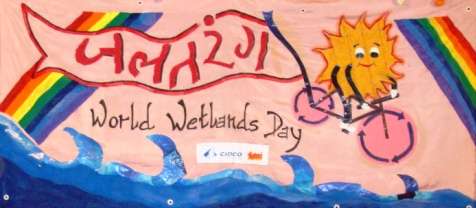Maharashtra
Jaltarang, a celebration of World Wetlands Day - An update from TERI's wetland management program in Navi Mumbai
Posted on 11 Mar, 2010 10:45 PM The satellite township of Navi Mumbai, with a total area of 344 km2, was developed in 1972 by CIDCO (City and Industrial Development Corporation) to de-congest the city of Mumbai. Initially a marshy land interspersed with villages, Navi Mumbai has been developed into a planned township, with much of its marshes and freshwater wetlands being converted into urban infrastructure.
The satellite township of Navi Mumbai, with a total area of 344 km2, was developed in 1972 by CIDCO (City and Industrial Development Corporation) to de-congest the city of Mumbai. Initially a marshy land interspersed with villages, Navi Mumbai has been developed into a planned township, with much of its marshes and freshwater wetlands being converted into urban infrastructure.
Navi Mumbai is a rapidly developing twin city. In the course of development, it was realized that more emphasis needs to be given towards the preservation and sustainable management of the freshwater wetlands it harbours. Given the vulnerability of these wetlands and their resource potential, there is an urgent need to develop a framework for sustainable use of freshwater wetlands. This requires efficient management systems and development of sustainable models, which would help maintain the natural characteristics of wetlands while also exploiting its potential to meet the socio-economic and recreational needs of communities. To tackle this important aspect, TERI conceptualized a pilot project with active support of CIDCO in October 2008. The Khandeshwar Lake was chosen as a model to demonstrate the feasibility as a ‘sustainable wetland’.
The attached presentation is an update on the work taken up and impact achieved since the start of the project, and includes details from the World Wetlands Day celebration organised on 2 February 2010. Details of TERI's wetland management program are here.
The Fourth Gender, Water and Equity Training Workshop in South Asia, SaciWATERs, Mumbai
Posted on 09 Mar, 2010 09:40 AMVenue: Mumbai
Organizer's: TISS, SaciWATERs, SOPPECOM, GWA
Hydrogeological studies for improved groundwater management strategies in the dryland areas underlain by Deccan basalts - ACWADAM
Posted on 02 Mar, 2010 05:18 PMGray water recycling
Posted on 28 Jan, 2010 04:08 PMGRAY WATER (Bathroom water) recycling project
General
Water expo 2010, Mumbai
Posted on 21 Jan, 2010 12:23 PMWater expo 2010
The fourth mega water event, Water Expo 2010 is scheduled at
Venue: Bombay Exhibition Centre
Save water from being flushed down-Thane Municipal Corporation adopts new method
Posted on 17 Jan, 2010 08:19 PMEvery time you flush, six litres of processed water goes down the toilet. Even though it may not be required. Thane Municipal Corporation (TMC) intends to arrest this wastage of water by suggesting a small modification in the flush tank. It costs less than Rs 5, but could save 25 to 30 litres of water for every household.
Agricultural Finance Corporation Ltd. (AFCL) is looking for Consultants in Water Resources Projects
Posted on 10 Dec, 2009 02:05 PMAgricultural Finance Corporation Ltd. (AFCL) is looking for Consultants for various areas of expertise in Water Resources Projects
Location: Maharashtra
Last Date: December 15, 2009
(Reference: DevNetJobsIndia.org)
Speakers and presentations of the WHSC 2009 Day 2 : Rajendra Singh emphasises the need for decentralized water management
Posted on 24 Nov, 2009 05:11 AM
Water management by industry - A case study of Reliance Energy - Dahanu
Posted on 17 Nov, 2009 06:03 PMThis presentation describes the work of Reliance Energy, in taking up water management initiatives with the local community around their plant in Dahanu. The work taken up includes constructing check dams, weirs and installing hand pumps for providing drinking water to the community. As a result of this, people in approximately 17 villages were benefitted as the availability of potable water improved and ground water levels increased resulting in higher incomes for the villagers.
